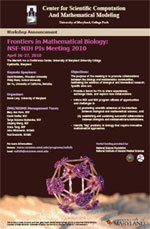NIGMS is looking for three program directors to manage a variety of research and training grants, and we’re also recruiting a scientific review officer to handle the peer review of grant applications.
The Division of Biomedical Technology, Bioinformatics, and Computational Biology has vacancies in both of its branches: Biomedical Technology (BT) and Bioinformatics and Computational Biology (BCB). Candidates for the BT position should have experience in developing or using advanced technologies for biomedical research in areas such as spectroscopy, microscopy, molecular or biophysical technologies, computational biology or informatics. For BCB, we’re seeking someone with expertise in computational biology, bioinformatics, biostatistics, health informatics and data science for biomedical research. We prefer candidates with a broad background in the application of computation for solving biological problems or expertise in two or more of the areas listed above.
The Division of Training, Workforce Development, and Diversity has a program director vacancy in its Postdoctoral Training Branch. Candidates should have knowledge of and/or experience in understanding, planning and managing research/student research development program(s) at the postdoctoral or early stage investigator career level, including those targeted to groups that are underrepresented in biomedical and behavioral sciences. Candidates also should have expertise in innovations for teaching in STEM fields as well as research experience in other scientific areas within the NIGMS mission.
Finally, we are seeking a scientific review officer to oversee the peer review of applications for a broad range of research and training programs, including programs aimed at capacity building and at increasing the diversity of the scientific workforce. We particularly seek someone with expertise in biochemistry, cell and molecular biology, computational biology, genetics and/or the pharmacological sciences to join our interactive scientific review team, although the position involves setting up and managing review groups across the range of biomedical and behavioral fields that NIGMS supports.
For all positions, candidates should have leadership, managerial, organizational, and strong oral and written communication skills. Familiarity with NIH extramural funding as a grant applicant, reviewer or NIH scientific administrator is a plus.
The vacancy announcements for these positions close on Monday, September 29. Please see the NIH HSA Web site for position requirements and application procedures. The Applying for Scientific Administration Jobs at NIGMS and Scientific Careers in the Federal Government blog posts offer additional background and tips.


 Last week, I attended the PI’s meeting for the Joint DMS/NIGMS Initiative to Support Research in the Area of Mathematical Biology, a program managed by us and NSF’s Division of Mathematical Sciences. A key goal of the program is to bring mathematicians and new mathematical approaches into the core of biological and biomedical research.
Last week, I attended the PI’s meeting for the Joint DMS/NIGMS Initiative to Support Research in the Area of Mathematical Biology, a program managed by us and NSF’s Division of Mathematical Sciences. A key goal of the program is to bring mathematicians and new mathematical approaches into the core of biological and biomedical research.